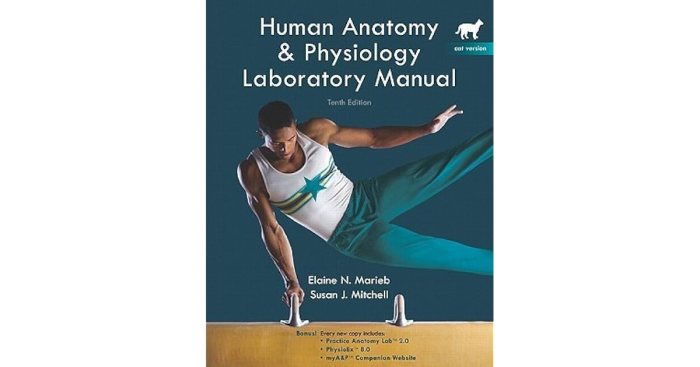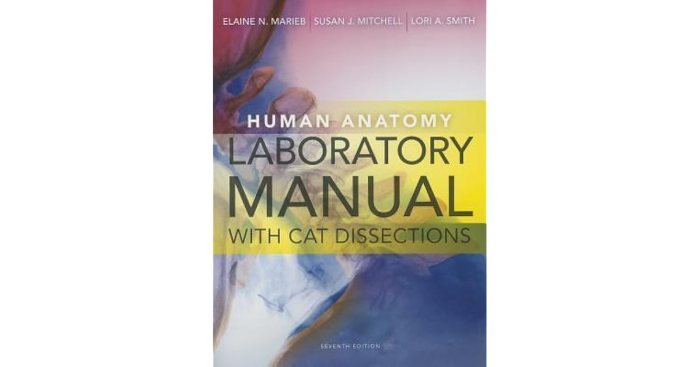Human anatomy laboratory manual with cat dissections marieb – The Human Anatomy Laboratory Manual with Cat Dissections by Marieb is an invaluable resource for students and practitioners of human anatomy. This comprehensive manual provides a detailed and systematic approach to the study of human anatomy through the dissection of cat specimens.
With its clear instructions, engaging content, and emphasis on safety, this manual is an essential tool for anyone seeking to gain a deep understanding of human anatomy.
This laboratory manual is organized into 12 chapters, each of which focuses on a specific body system. Each chapter begins with an overview of the system’s structure and function, followed by detailed instructions for the dissection of cat specimens. The manual also includes a wealth of illustrations, photographs, and tables to help students visualize and understand the anatomical structures being studied.
Introduction

A human anatomy laboratory manual with cat dissections is an essential tool for students of human anatomy. It provides a comprehensive guide to the dissection of a cat, and it includes detailed descriptions of the major anatomical structures. This manual is designed to help students understand the structure and function of the human body, and it can be used in conjunction with a textbook or other resources.
The manual is organized into 12 chapters, each of which covers a different anatomical system. The chapters are arranged in a logical sequence, and they begin with an overview of the skeletal system. The remaining chapters cover the muscular system, nervous system, circulatory system, respiratory system, digestive system, urinary system, reproductive system, endocrine system, and integumentary system.
Materials and Methods
The materials and equipment needed for the laboratory exercises in this manual include a cat, a dissecting kit, a scalpel, a forceps, a scissors, a probe, and a ruler. The general procedures for dissecting and examining cat specimens are as follows:
- Identify the anatomical structures to be dissected.
- Make a small incision in the skin and underlying tissue.
- Carefully dissect away the tissue to expose the anatomical structures.
- Examine the anatomical structures and identify their major features.
- Record your observations in a laboratory notebook.
Safety precautions and ethical considerations should be followed when dissecting cat specimens. These precautions include wearing gloves, a lab coat, and safety glasses. It is also important to dispose of the cat specimen properly after the dissection is complete.
Skeletal System: Human Anatomy Laboratory Manual With Cat Dissections Marieb
The skeletal system is the framework of the body. It provides support, protection, and movement. The skeletal system is composed of bones, which are hard, white tissues that are made of calcium and other minerals. The bones are connected to each other by joints, which are flexible structures that allow for movement.
The skeletal system also includes ligaments, which are tough bands of tissue that connect bones to each other, and tendons, which are tough bands of tissue that connect muscles to bones.
Major Bones of the Cat Skeleton
- The skull
- The vertebral column
- The ribs
- The pelvis
- The limbs
Muscular System
The muscular system is responsible for movement. The muscular system is composed of muscles, which are soft, elastic tissues that are made up of muscle fibers. Muscle fibers are long, thin cells that contain actin and myosin, which are proteins that interact with each other to cause muscle contraction.
Types of Muscles
- Skeletal muscle
- Smooth muscle
- Cardiac muscle
Nervous System
The nervous system is responsible for controlling the body’s functions. The nervous system is composed of the brain, the spinal cord, and the nerves. The brain is the center of the nervous system, and it is responsible for processing information and controlling the body’s activities.
The spinal cord is a long, thin bundle of nerves that runs from the brain to the rest of the body. The nerves are thin, thread-like structures that carry messages from the brain to the rest of the body and from the rest of the body to the brain.
Major Structures of the Brain
- The cerebrum
- The cerebellum
- The brainstem
Circulatory System
The circulatory system is responsible for transporting blood throughout the body. The circulatory system is composed of the heart, the blood vessels, and the blood. The heart is a muscular organ that pumps blood through the blood vessels. The blood vessels are a network of tubes that carry blood throughout the body.
The blood is a fluid that contains red blood cells, white blood cells, and platelets.
Major Structures of the Heart
- The right atrium
- The right ventricle
- The left atrium
- The left ventricle
Respiratory System

The respiratory system is responsible for exchanging gases between the body and the environment. The respiratory system is composed of the lungs, the airways, and the diaphragm. The lungs are two large, spongy organs that are located in the chest cavity.
The airways are a series of tubes that carry air to and from the lungs. The diaphragm is a large, dome-shaped muscle that separates the chest cavity from the abdominal cavity.
Major Structures of the Respiratory Tract, Human anatomy laboratory manual with cat dissections marieb
- The nose
- The pharynx
- The larynx
- The trachea
- The bronchi
- The bronchioles
- The alveoli
Digestive System
The digestive system is responsible for breaking down food into nutrients that can be absorbed into the bloodstream. The digestive system is composed of the mouth, the esophagus, the stomach, the small intestine, the large intestine, and the rectum. The mouth is the opening through which food enters the body.
The esophagus is a muscular tube that carries food from the mouth to the stomach. The stomach is a large, J-shaped organ that secretes acids and enzymes that break down food. The small intestine is a long, coiled tube that absorbs nutrients from food.
The large intestine is a shorter, wider tube that absorbs water from food and stores waste products. The rectum is the final part of the digestive system, and it stores waste products until they are eliminated from the body.
Major Organs of the Digestive Tract
- The mouth
- The esophagus
- The stomach
- The small intestine
- The large intestine
- The rectum
Essential Questionnaire
What is the purpose of the Human Anatomy Laboratory Manual with Cat Dissections?
The purpose of the Human Anatomy Laboratory Manual with Cat Dissections is to provide students and practitioners of human anatomy with a detailed and systematic approach to the study of human anatomy through the dissection of cat specimens.
What are the benefits of using the Human Anatomy Laboratory Manual with Cat Dissections?
The benefits of using the Human Anatomy Laboratory Manual with Cat Dissections include: – Provides a detailed and systematic approach to the study of human anatomy – Includes clear instructions for the dissection of cat specimens – Features a wealth of illustrations, photographs, and tables to help students visualize and understand the anatomical structures being studied – Emphasizes safety and ethical considerations
Who is the Human Anatomy Laboratory Manual with Cat Dissections intended for?
The Human Anatomy Laboratory Manual with Cat Dissections is intended for students and practitioners of human anatomy, including: – Undergraduate and graduate students in anatomy, biology, and related fields – Medical students and residents – Physicians and other healthcare professionals